Tuesday, May 29, 2007
Sunday, May 27, 2007
CC2 - Week 11 - Distributed Performance

John "Shredder" Delany and myself ("Splinter") teamed up to make use of the MaxMSP Open Sound Control implementation. Our data flow was more or less:
>A Novation MIDI Keyboard plugged into MaxMSP on my laptop
>Max sent note data through the wireless network to a G5 Mac
>The G5 used a Max 'route' object to send this data back through the wireless network to John's laptop
>John's Max patch either transposed or velocity-modified (or both or neither) the note data, and various controller data could be created from hsliders.
>John's laptop sent the changed note data and controller data back through the wireless network to the G5
>The G5 routed this data back through the wireless network to my laptop
>My Max patch sent the data to Cubase, where the A1 VST synth interpreted it
Through this we essentially created a wireless connection between our laptops with a G5 as a signal router. We certainly enjoyed the performance, with the resulting space-age sci-fi sound providing much entertainment. ~MP3 829KB~
~Patch/Cubase Files 35KB~
 The A1 effects that were controlled by John's patch were Cutoff, Attack and Detune, with the Attack also being controlled by my pitch bend wheel so we could 'argue' over control. He also had a pitch transposer (+12 or -12) and a velocity modifier that changed any velocity under 40 to 127 (except 0 velocity).
The A1 effects that were controlled by John's patch were Cutoff, Attack and Detune, with the Attack also being controlled by my pitch bend wheel so we could 'argue' over control. He also had a pitch transposer (+12 or -12) and a velocity modifier that changed any velocity under 40 to 127 (except 0 velocity). My patch used prepends to make sure the data would go to the correct route outlet on the G5, and also routed note and control data from John to the respective inlet of midiformat, which was then sent to Cubase.
My patch used prepends to make sure the data would go to the correct route outlet on the G5, and also routed note and control data from John to the respective inlet of midiformat, which was then sent to Cubase.
The G5 router simply made sure data from me was sent to John and data from John was sent to me. We had an issue with John's computer randomly changing IP addresses, so every now and then we had to stop and wait for it to change back to one of the IP's that we were sending to. Apart from that it was all fairly straight forward.
Level Completed by
Ben
on
Sunday, May 27, 2007
4
mushrooms
![]()
Saturday, May 26, 2007
AA2 - Week 11 - Mastering
I was surprised at how much louder I could get my mix sounding when incorporating the multi-band compressors, however I think I may have overcompressed the lower end, as the kick drum seems to have lost a bit of its punch. After mixing it down, I imported it into Audacity to see if I could bring it up even further. I would usually just use the 'Amplify' option, however this time I duplicated the file onto a separate track, and used the previously mentioned 'Matrix Spatialiser' to change the stereo field so that it was at a full 180 degrees, meaning it sounds like it is directly behind you. I mixed this back into the original track, so not only did it amplify the wave but added a fuller sound to the whole thing. The effect of this can particularly be heard on the snare hit at the end of the first chorus, where it sounds as if it is hit in front of you then reverbs way out to either side. I am also pleased with the nearly-wall-of-sound level that the humorously emotional ending has, which was thanks to a fairly wide midrange compression. Overall I still did not reach the volume of the likes of Nine Inch Nails, but I guess 'mastery' comes with experience. Eh? EH!? Yeah.
~MP3 312KB Unmastered extract~
~MP3 367KB Mastered extract~
~MP3 3.69MB Mastered complete~
David Grice “Audio Arts, Week 11: Mastering” Tutorial presented at Studio 2, Electronic Music Unit, University of Adelaide, 22nd of May, 2007.
Level Completed by
Ben
on
Saturday, May 26, 2007
0
mushrooms
![]()
How To Operate Your New Macintosh (Part 1)
Level Completed by
Ben
on
Saturday, May 26, 2007
3
mushrooms
![]()
Thursday, May 24, 2007
Forum - Week 11 - Mass Debate 6

This week for forum we continued the discussions on Construction and Deconstruction. First up was DJ Puff’n’Fresh, who used the opportunity of a captive audience to promote… well, himself. Marked with good humour and an unstoppable catchphrase, Puff danced around the validity of remixing, and gave examples of bad remixes and good remixes, most of which I agreed with apart from Stardust. I am a huge fan of early Funk and Soul, so I personally find it difficult to enjoy remixes of already good songs. In a way I am grateful that remixes can ‘rekindle’ the life of a good song, allowing the same formula to be enjoyed by the current generation, however it should be done in a way that is faithful to the original and preferably does not completely suck.
Cooper Afro ("Af" to his friends) seemed to be ill-prepared for his presentation, as I still do not see his main point. He alluded to the difference between Black Metal and House music, however did not drive any point home with research or explanations. I had not heard Black Metal before, and I found it to be quite ridiculous. I think that the only reason somebody might enjoy it is due to the inherent white noise throughout, which is of course calming to the human mind.
John "John" Delany delved into dark ambient music and its use in film as an emotional stimulator. I found the excerpts he played to be highly thought provoking, with complex mental imagery being implied in the music of Lustmord, Robert Rich et al. It was nice to finally have something to think about, considering the previous presentations were a little light on depth.
Stephen Whittington. “Music Technology Forum: Construction and Deconstruction.” Workshop presented at EMU space, Schultz building, Adelaide University, 24th of May, 2007.
Level Completed by
Ben
on
Thursday, May 24, 2007
2
mushrooms
![]()
Wednesday, May 23, 2007
CC2 - Week 10 - Interface Design
Got Wood? The following zip file contains the main patch "MaxWeek10" and the associated Cubase file "CubasWk10". Remember to set the inputs and outputs on the patch so it is where you intend the signal to go/come from. All the graphics were made on Adobe Photoshop CS2, using a couple of background images I downloaded, namely a wood one and a strange golden pellet one. After struggling for ages with 'coll', I decided to just use the 'seq' MIDI recorder, and I am very glad I did due to the ease of use. Some of the buttons etc. may not line up properly on some computers- they have been set to look correct on the Macs in the Audio Lab.
When switching on the Probability Note Generator, there is a small animation akin to an old analog display booting up. I did this by fading the colour of the multislider from black to yellow, and sending a bpatcher with the note names in it some staggered offset data, stored in a coll. You may also notice that the multislider itself looks different- there are underscores covering the sliders in such a way that it seems to have blocks instead of sliders. There is indepth descriptions of the Envelope Randomiser inside the patch "bkp.Slidermania". The Note Generators are in the patch "bkp.ProbAndRand".
To access the rest of the patch, unlock the window and click on the message "window title, window exec".
~Patch File 1.4MB~
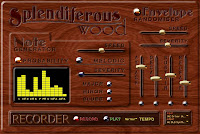
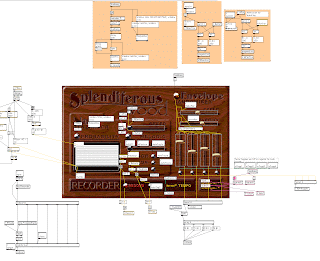
Main GUI Unlocked
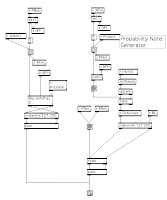
Random Generator Control Centre
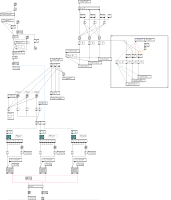
Melodic Generator
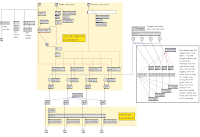 Smooth Random and After Sliders
Smooth Random and After Sliders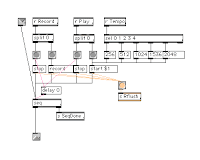
Recorder
Level Completed by
Ben
on
Wednesday, May 23, 2007
6
mushrooms
![]()
Monday, May 21, 2007
AA2 - Week 10 - Avalon Antics

I teamed up with Luke this week to record piano through the Avalon preamplifier. We used the old faithful midside mic position, and recorded one take through the Avalon and another through the Control 24 mixing desk. The result had a somewhat noticeable difference between the two, however I am still undecided on which I prefer. I believe they are both aurally pleasing, and each sound would probably be well suited to different situations. I am interested to see if anyone tried recording voice for the comparison, as I would imagine the Avalon would have a very nice effect on a female jazz voice.
AVALON MP3 300KB
C24 MP3 348KB
Level Completed by
Ben
on
Monday, May 21, 2007
0
mushrooms
![]()
Thursday, May 17, 2007
Forum - Week 10 – Mass Debate 5
For forum this week I was running on 3 hours sleep, so time felt like it was going backwards. The topic was “Construction and Deconstruction”, and nobody made a single CODEC joke. Until me, just now.
Classmate and all-round good guy “Craaaaaazy” Matt Mazzone deconstructed a television advert that he provided the music and foley for. I ended up being the star of the show, with my squeal sound effect for the turning tap proving to be a huge success. Matt’s use of diagetic and non-diagetic sound in one of his other adverts renewed my faith in tertiary education- this was a prime example of the application of pointless knowledge in real life.

Dragos “JC” Nastyman examined how song structures are constructed and deconstructed over time in various pieces of music. I had never really thought about this aspect of music to any great extent, so it was intriguing to hear examples of various artists with different approaches to introducing ideas into a song, and also in removing ideas.
 Frederick May was up last (according to my state of mind), and attempted to deconstruct popular music to find out what makes it so popular. Using internet sources, he stated other people’s ideas on the topic, and strangely disabused them straight away. I’m not sure if his point was “Look at how I could not find any serious information on my topic” or “Listen to me prove that there is a lot of crap on the internet”, but in either case I was in agreement. He did quote a section from a book by Michael Stavrou, which stated some psuedo-mathematical formula for the creation of a popular song. I know music is symbiotic with mathematics, but reducing the creative process in composition to 4 addition sums seems a little too easy. One gleaming aspect that was missing from the formula was the ‘addition’ of musical talent, however I suppose the popularity of some dance tracks proves that musical talent does not necessarily need to factor into the creation of a piece of music (sic).
Frederick May was up last (according to my state of mind), and attempted to deconstruct popular music to find out what makes it so popular. Using internet sources, he stated other people’s ideas on the topic, and strangely disabused them straight away. I’m not sure if his point was “Look at how I could not find any serious information on my topic” or “Listen to me prove that there is a lot of crap on the internet”, but in either case I was in agreement. He did quote a section from a book by Michael Stavrou, which stated some psuedo-mathematical formula for the creation of a popular song. I know music is symbiotic with mathematics, but reducing the creative process in composition to 4 addition sums seems a little too easy. One gleaming aspect that was missing from the formula was the ‘addition’ of musical talent, however I suppose the popularity of some dance tracks proves that musical talent does not necessarily need to factor into the creation of a piece of music (sic).Stephen Whittington, "Forum Week 10: Construction and Deconstruction" Workshop presented in Recording Space, Electronic Music Unit, University of Adelaide, South Australia, 17th May 2007.
Level Completed by
Ben
on
Thursday, May 17, 2007
3
mushrooms
![]()
Tuesday, May 15, 2007
CC2 - Week 9 - Data Management and Application Control
Considering I have a theory test worth 15% of my grade on Wednesday, this week's patch is a little lacklustre in the aesthetic department, however I still love the 80's brown and orange theme I whipped up. I went the direction of non-minimalism with the patch setup, as you can tell with my complete lack of bpatchers. A couple new concepts I tried this time: using the transparent button as a toggle to create a blue highlight around anything it was on top of when switched on, and setting up a bypass system for the function formulas so they could be turned on in any combination without stopping the data flow.
I originally ran Delta Time into the coll packaged with pitch, velocity and note length data, but upon connecting the outputs of the coll to makenote I realised that there is nothing to send delta time to. I spent a good couple hours trying to set up the 'tempo' (controlling the output of the coll) to use delta time data to control time between each note out, but then realised that I was essentially creating a 'seq', and I don't believe this was an intended objective. In any case, I left the delta time code in the patch.
I'm not sure if there's an easier way than I have done it, but I have the data in my coll being output backwards, so that the output matches the order that it was entered. I have also just noticed that the kslider in not connected to the recorder. Hmm. Uh- I only had the kslider there to illustrate what notes are being played on the MIDI input device. Yes.
I have connected note velocity to also control a knob in the A1 synth in Cubase. I picked this effect in particular as it seemed to be the most noticeable. The velocity data needed to be adjusted so that it had a real effect on the control.
I find the preset window ugly and not user-friendly, so I simply used message boxes to control the preset box and took it out of the user's face.
Patch and Cubase Files
~MP3 276KB~

Christian Haines "Creative Computing 2, Semester 1, Week 9: Data Management & Application Control" Lecture presented at the Electronic Music Unit, University of Adelaide, South Australia, 10th May 2007.
Level Completed by
Ben
on
Tuesday, May 15, 2007
3
mushrooms
![]()
Monday, May 14, 2007
AA2 - Week 9 - Mixing Techniques 2
For something different I decided to mix an entire song using only the Drama Queen files. I was quite surprised how useful some of the extraneous guitar riffs were, one of which I used as the main theme of my mix. I was even more surprised when converting my mixdown to an MP3, and I spotted one of the guitars going out of time in the second verse- you'd think that ProTools could handle real time mixdowns, but I guess not. If I was to clarify a genre for the piece, I suppose whatever genre Evanescence is would suit.
The double kick was simply double delay lines, the double-time hihat again used delay and the reverse crash cymbal at the start was just that. I spent a fair amount of time on spacial positioning and movement of sounds, so you might notice some 3-dimensional panning if you're sharp. I also experimented with the voice a bit, as you'll hear with some of the extended song lines ("Always..."). Something that helped a lot was taking the recording from Studio 1 into Studio 2, and listening to it on different speakers in a different room. This highlighted some of the inconsistencies that aren't easily clarified on the Tannoy's. I also had a couple baffles set up behind me in Studio 1, which stopped the awful sound of the room.
The file is a little larger than usual, as would be expected for a 3 minute long song. ~MP3 3.87MB~
I have just found a txt file of 'things to fix' that I made when I took the mix home and listnened to it on my Logitech speakers and through headphones.
~acoustic interjections are tool loud
~cool 'accident' guitar fade needs to be louder
~voice sounds like a bathroom- thanks NoTools
~start guitar could be less mono
~voice excerpt in outro would break up monotony
~fade out of final guitar in outro bathroomy
~lessen reverb on snare in verses
~main guitar very mono... fix
~try and stretch out the 'always' part of the screaming section- maybe use to fill in the following instrumental as well?
~more crash and ride in instrumental
~fadein guitar in instrumental gets too loud
~fade in the outro guitar slower, over whole chorus maybe, and have the chorus guitar fade out AFTER chorus.
~stereo reverb (or something) needed on fake hihat- too directionally specific at the moment
~more high end needed on guitar on "open up" breakdown
~tiny bit less bass on kick drum
~"cover" and "always" in chorus out of time
~doubletime bass notes in outro could do with copycat kick drum
~watch volume changes when bypassing delay lines in kick -volume of kick in 'open up' breakdown perfect
These were of course fixed for the final mix, except for the word "cover" in the chorus- moving it created an awkward gap in the sentence.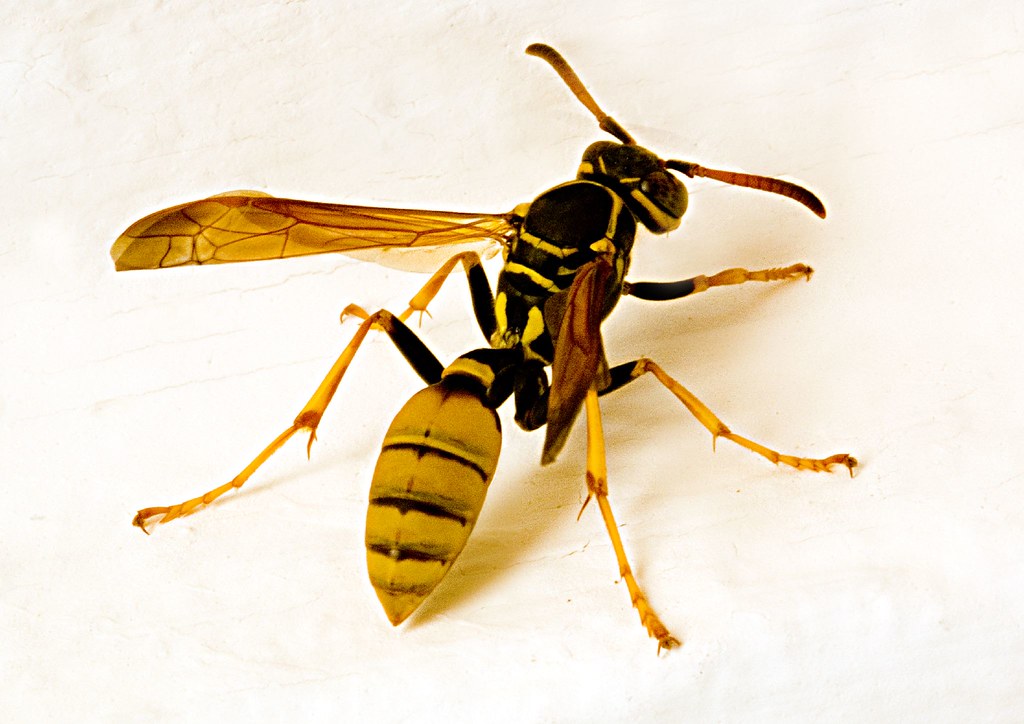
Level Completed by
Ben
on
Monday, May 14, 2007
5
mushrooms
![]()
Wednesday, May 09, 2007
CC2 - Week 8 - MIDI Information and Virtual Instrumentation
This week we had to create a Max patch that used random generators to change settings in Reason (1). I have had little experience in Reason after strategically avoiding it throughout first year, so this was very much a learning experience in that regard. As well as a normal random note generator, I implemented the Probability Note Generator from week 7's exercise, now expanded to include 5 or so octaves instead of just the one.
After creating the smooth-sliding randomiser (see: help file within bkp.NN19filter.pat), the patch was pretty much a copy and paste affair, with the UI and Reason effects the only real changes needed. I ended up applying randomisation to the Reason NN19 effects Filter (Freq, Attack), Amp (A,D,S,R) and Osc (Pan). Some of these needed related settings changed as well (like 'Res' in Filter), so they have automation applied that is controlled by either the on/off switch for that patch or the Reason initialiser button.
While on the topic, the Initialise Reason button is to be used when the NN19 has been opened in Reason and is set up to accept data from Max. This was originally done using loadbangs, however if you load the patch and then load Reason, the loadbangs do not set up the initialisation data needed for certain settings (again, such as 'Res' in Filter). Hence, a button as been supplied for such use. This also automatically sets MIDI outputs to "from MaxMSP 1", so you don't need to click around for 10 minutes, just set up Reason on this output.
I would have liked to make it a bit more aesthetically pleasing, but I attempted to do some work for a subject other than Music Tech over the weekend and subsequently had to rush the patch.
The main patch is fallaciously named "MaxWeek9", as I was too scared to correct any file names this close to the due date.
~Max Files~
~MP3 500KB~

1. Christian Haines "Creative Computing Semester 1 Week 8: MIDI Information & Virtual Instrumentation." Lecture presented at the Electronic Music Unit, University of Adelaide, South Australia, 3 May 2007.
Level Completed by
Ben
on
Wednesday, May 09, 2007
5
mushrooms
![]()
Sunday, May 06, 2007
AA2 - Week 8 - Mixing Techniques 1

I find it hard to identify what the improvements of NoTools are in this updated version. Sure, the EQ's are cool, but they're just the same as third-party EQ's from 3 years ago. Anyway, my 3 mixes of 'Drama Queen' are quite differing in their style, perhaps as a subconscious attempt to relieve the apathy of the pop music style. I chopped up the vocal track quite severely to try and remove the backing guitar, so if a word fades out before finishing, it was just me making an executive decision to save the rhythm.
~MP3 700KB~Mix 1 is what you might call 'easy listening', with nothing too offensive to the ear. Only acoustic guitar was used, and the drums have a light reverb. I used a plug-in from Audacity called "Matrix Spatialiser" to widen the stereo field, giving the mixdown a fuller sound.
~MP3 696KB~Mix 2 is designated the "Rock Mix", and makes full use of the Amplitube plug-in. The drums have a more surreal reverb than before, and the snare is a little tighter and punchier. Listen out for the gut-busting (sic) guitar solo at the end of the sample.
~MP3 668KB~Speaking of Amplitube, Mix 3 is my tribute to everything not pop. Lovingly called 'THD Mix', this was actually the first mix I made, but it makes more sense when in the context of the previous two. The bass guitar has a meaty distortion with a light wah, and the vocals have a duplicate track with an overdriven counterpart. The snare is also filtered through Amplitube, with overdrive and strategic delay settings giving it the not-so-snarey sound. The kick had some light distortion, which really gave it a punch compared to the last two mixes. If only the vocal track didn't have the guitar strumming- the voice could have been a little more distinguishable.
My ProTools session files are in the dropbox under "Ben Probert AA Week 8".
1. David Grice "Audio Arts Semester 1 Week 8: Mixing Techniques 1." Lecture presented at the Electronic Music Unit, University of Adelaide, South Australia, 1st May 2007.
Level Completed by
Ben
on
Sunday, May 06, 2007
2
mushrooms
![]()
Friday, May 04, 2007
Forum - Week 8 - Mass Debate 4
The final week of 'Gender in Music Technology'(1), and the presenters once again amuse and bemuse. Bradley Leffler was welcomely direct in saying that the reason for different interests between genders is because the genders are different, so they would have different tastes. I'm glad somebody finally pulled out the obvious stick and beat the topic to death with it. He also made an interesting segue to Kraftwerk and their replacement of gender and indeed humanity with technology. (Not intentionally ripping off Dave's blog) I found the aspect of live performance in the Kraftwerk video he played to be a humanising of technology, where the humans walked the line between organic and mechanical. NB: Brad, don't ever quote Wikipedia as a research source, even if you use it. Every time somebody does, I hear a toilet flush.
Laura Gadd expanded on Amy's presentation last week. I just noticed that two of the three (two?) girls doing this course were given this topic- a gender-based selection? Surely not... Laura used Eminem and Pink to examine the different approaches to anger in music between genders, but I think everyone already knew that men are generally more violent than women. Before you all start at me, I didn't say all men are violent. Calm down, before you prove my point. During the Eminem spiel, I couldn't help but think of Barry White, rest in peace, and his contribution to (respectable) masculine love songs, along with Marvin Gaye, Burt Bacharach et al. Surely such crooners help to establish the possibility of some men being caring, non-violent people? Interesting side note, my sister just got married and her initials are now M.M.

As you probably already know, anyone who has the same name as me is instantly my enemy, so Ben Cakebread wasn't off to a good start. Ben presented more of a generalised 'Sexuality in Music' topic than anything to do with gender or music technology, which was a still nice change from the last six presentations. Uh, five, not including myself. The band Queen was used as an archetype of the discrimination towards homosexuality, with several specific instances of discriminatory behaviour by the general public being brought to light. In fact, the entire presentation was more about how they were originally persecuted for their outwardly homosexual lifestyle, then 'got back' at all the nay-sayers. I fail to see the link between this and the given topic, and I found it to be more like a seized opportunity to express one's view instead of a researched and learned opinion.

Lastly, Peter Kelly shed some light on all things already illuminated, and some things that are supposed to remain in the dark. I was constantly waiting for the connection between raised topics and gender in music technology, but to no avail. What on earth do the drug smuggling scum in Indonesia have to do with gender, let alone music? Keep your clichéd anti-government bullshit for when it can be used in context, maybe then you won't get so many furrowed brows.

1. Stephen Whittington “Music Technology Forum Week 8: Gender in Music Technology” Workshop presented at EMU Space, Level 5, Schultz building, University of Adelaide, 3rd May 2007.
Level Completed by
Ben
on
Friday, May 04, 2007
3
mushrooms
![]()
Tuesday, May 01, 2007
Windows Update
Ah HA! Now you don't have a choice, Mac users! Feel the wrath of our mighty leader Bill!
Level Completed by
Ben
on
Tuesday, May 01, 2007
8
mushrooms
![]()
Here's Some I Prepared Earlier...
-
►
2008
(43)
- ► December 2008 (2)
- ► November 2008 (1)
- ► October 2008 (2)
- ► September 2008 (4)
- ► August 2008 (9)
- ► April 2008 (9)
- ► March 2008 (11)
-
▼
2007
(74)
- ► December 2007 (1)
- ► November 2007 (3)
- ► October 2007 (6)
- ► September 2007 (9)
- ► August 2007 (12)
-
▼
May 2007
(14)
- How To Operate Your New Macintosh (Part 2)
- CC2 - Week 11 - Distributed Performance
- AA2 - Week 11 - Mastering
- How To Operate Your New Macintosh (Part 1)
- Forum - Week 11 - Mass Debate 6
- CC2 - Week 10 - Interface Design
- AA2 - Week 10 - Avalon Antics
- Forum - Week 10 – Mass Debate 5
- CC2 - Week 9 - Data Management and Application Con...
- AA2 - Week 9 - Mixing Techniques 2
- CC2 - Week 8 - MIDI Information and Virtual Instru...
- AA2 - Week 8 - Mixing Techniques 1
- Forum - Week 8 - Mass Debate 4
- Windows Update
- ► April 2007 (9)
- ► March 2007 (13)
-
►
2006
(42)
- ► December 2006 (1)
- ► November 2006 (16)
- ► October 2006 (12)
- ► September 2006 (1)
- ► August 2006 (11)



